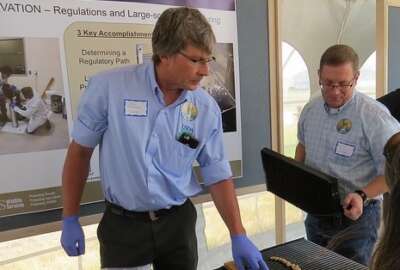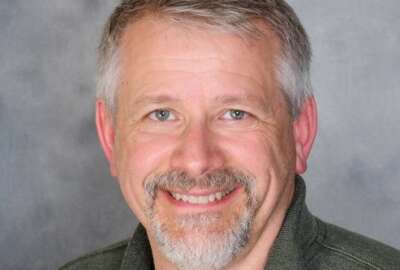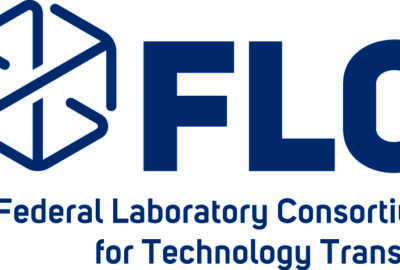
A visit with the new chairwoman of the Federal Laboratory Consortium
The director of NSA's Office of Research and Technology Applications is the new chairwoman of the Federal Laboratory Consortium.
Best listening experience is on Chrome, Firefox or Safari. Subscribe to Federal Drive’s daily audio interviews on Apple Podcasts or PodcastOne.
You might not think of the National Security Agency as a federal laboratory that does technology transfer, but it is, and it does. And now the director of its Office of Research and Technology Applications is the new chairwoman of the Federal Laboratory Consortium. For the first in a series of interviews on the consortium and tech transfer, Linda Burger joined Federal Drive with Tom Temin.
Interview transcript:
Tom Temin: Ms. Burger, good to have you on.
Linda Burger: Thanks for having me, Tom. I’m happy to be here with you today.
Tom Temin: And let’s begin briefly with the NSA and its technology transfer activities. I guess my question is, is this with respect to the research that the agency itself does? Or is it funded by grants research that you’re talking about here?
Linda Burger: Everything that my office is involved with deals with technology that’s federally funded, that was developed by the government, for the government for our NSA mission use.
Tom Temin: Okay, like I said, in the beginning, people may not realize how much research the NSA does, in addition to its operational duties.
Linda Burger: So we have patents available for licensing, we have a portfolio that’s online at nsa.gov/techtransfer. And you can see our online portfolio there, where we have over 100 technologies currently available for licensing that – they were developed perhaps in a classified environment or for a classified application. But the technology itself is unclassified. And so we’re able to apply for and earn patents from the U.S. Patent and Trademark Office, when our inventors do that work they do for mission, and then our office’s job is to develop and license that intellectual property that’s been developed from that federally funded work. And part of our job is also to create partnerships for the agency. So we create technology transfer based partnerships, such as Cooperative Research and Development Agreements, education partnership agreements, other things where we help facilitate interaction between NSA as a federal lab, and the external environment to move our technologies out, to move things from the lab to the marketplace. That’s a big part of technology transfer is moving these federally-funded innovations from the lab to the marketplace. And so our office does all that for NSA.
Tom Temin: Interesting, and can you give us just a general idea of the areas or domains that these patents fall in, for example, imaging or computer processing, that kind of thing?
Linda Burger: Absolutely. We’ve divided our catalog or portfolio into five different sections. We have data science, internet of things, physical security, cybersecurity, of course, right? I think the one that’s been most surprising for me is – I came to this job, and [since] I’ve been here – is the physical security piece. National Security Agency, security is our middle name. But I never thought on the outside before I came here about all the physical security devices that this agency develops for the DoD use because we are a DoD element. And we support the warfighter. But things like tamper evidence port protectors and things that secure things physically. So we are both in the technology side as well as the physical security.
Tom Temin: So you must have gotten some great ideas for how to fence in your backyard?
Linda Burger: Well, or secure a manhole cover, or have secure double-seal bags we have for licensing where it’s like, you have to send samples or specimens in certain places. And so we’ve got double sealed bags, we’ve got wonderfully amazing adhesive tapes that we can use that basically, if sometimes you try to remove a piece of tape, that’s fine, easy enough. But we’ve got ones that again, it’s all tamper evident. It’s kind of like the security system at your house. If you get that it’s peace of mind. But if somebody really wants to get in, they’re going to get in. So what we need is tamper-evident material so that when we say that something’s been tampered with, we know we have a problem, and we can address it.
Tom Temin: I wish I had that on my liquor cabinet when my kids were teenagers, but the time has passed, ow.
Linda Burger: Note to self, a new application space, right?
Tom Temin: And you come from the private sector. So you sound like one of the converted to what is going on in the public sector here.
Linda Burger: It’s interesting, actually, this is my second time at NSA. So I started here in the doing it work right out of college and was here for a while and then went and did other things. I worked for local government, for private sector, I’ve had my own company, I got into economic development, doing tech-based economic development around tech transfer once I learned about that, and found out what that was, I thought this is really intriguing and cool. And it’s like as a business owner, I had tried to create a technology product and frankly, my company failed. We were not successful in our product development. So we try to figure out how could we do that better? And learning about technology transfer was a way that I found you can leverage the investments that the federal government has already made in the basic and applied R&D efforts or research and development, so that technologies are further ready to commercialize and then you can license you can pay a patent license to a federal lab to leverage that already intellectual property protected or patent protected technology for your business. And it can catapult you ahead because you’re now able to instead of doing the work yourself You’re able to purchase and through the patent license agreement buy that the benefit of that federally funded research to benefit your own company. So through trial and error, I like to believe I’m helping other people kind of avoid the same mistakes my company made when we had it. But it’s a great opportunity to leverage the federally funded innovations and move businesses forward. And we’ve had companies formed around our technology so companies can form, new jobs can be created, new and enhanced products can be developed all around federally funded technology.
Tom Temin: We’re speaking with Linda Burger, she’s the chairwoman, or will be this fall, of the Federal Laboratory Consortium, and also director of the Office of Research and Technology Applications at the NSA. And let’s talk about the Consortium for a minute, you’re very active there, you will be the chair of it come October. What are your plans for the consortium? Because that’s where all of the like-minded technology transfer brains get together, correct?
Linda Burger: Right. It’s the Association for Federal Technology Transfer Professionals. And my hope is to continue the good work that we’ve been doing. The current chair, John Dement has worked over the past number of years with the full executive board and our National Advisory Council have a group of experts who advise us, we put together a strategic plan for the organization, we’re moving forward with those initiatives. My hope is to continue those and the highest priority and on my docket, if you will, is our educational content. So we have education content that we have, we have normally delivered in an in person manner at our national and regional meetings. And we’re looking to move all of that education content to an online platform. So that’s going to be a big lift for us. And I really look forward to having the opportunity to work with the group on that effort.
Tom Temin: And you also operate a regional awards program. I just got a release on that. What’s that all about and how does it work?
Linda Burger: So that is part of the FLC’s larger effort. So back up a smidge, we have national and regional awards, we have three main things that we do: We promote, educate and facilitate federal technology transfer. And that’s talking about what it is the value of it, and highlighting the accomplishments and opportunities in the space and just kind of to level set things early on, technology transfer is the exchange of knowledge, capabilities, research breakthroughs between federal laboratories, and external parties. And that could be industry, academia, even nonprofits. And so we’re doing that work of technology transfer, moving these federally funded innovations from lab to the marketplace, so that we can get that it’s a long-term economic development strategy and return on investment to the taxpayer for that federal R&D investment. Every year, that federal r&d investment and every year the federal government invests over $100 billion in basic and applied research and development across the government enterprise. So getting these innovations from a lab to the marketplace is a really significant, impactful job that professionals in our organization do in tech transfer across federal government. And so part of the promoting tech transfer, we promote, educate, and facilitate, is our awards program to come back to that. And what we do is we highlight kind of the best of the best, both nationally and our national awards program and in the regional awards program. So these are competitive awards. There’s a annual regional event, there’s six geographic regions currently at one national meeting. And at those events, we host excellence in tech transfer award programs.
Tom Temin: Sure, and that leads me to my question – tech transfer, the way you describe it, to the uninitiated sounds like a fairly straightforward process. Someone comes and says, “I like to license this. Okay, here’s $5. It’s yours to license.” But I’m imagining it’s much more than that. And so what are some of the challenges to successful technology transfer?
Linda Burger: One thing that we must have is a development plan for the technology. So we have to have either a business plan or some sort of technology development plan. So when you come to a government lab, there is a FLC business site on the Federal Labs Consortium’s website. It’s federallabs.org. They have FLC business as part of that site, where it talks about all the technologies that are available for licensing from federal labs and capabilities, different federal labs that you can find there. So we do have a little more rigorous steps we need to go through. We’ve tried to simplify it at NSA down to eight steps from finding the technology, we put you under nondisclosure, we hook you up with the inventors to have that conversation, see if it’s a fit. We negotiate terms, we license the agreements, if you want an exclusive license, we must do a federal register notice. That’s 15-day notice in the Federal Register, but other than that, it’s like once we come to terms of the license that we agree to has to go through legal review on both sides, and then you’re good to go. So it’s for our office. Each license is unique, you know, others may do it differently. I think the the one requirement that we must have is a development plan and a federal register notice if it’s an exclusive patent license.
Tom Temin: Yeah, so it sounds like you look into and need to be assured of the competence of the person. Applying for the license and also that you keep out just the patent trolls.
Linda Burger: Well, so the license requirement we leverage a partner that’s Pentagon funded to help with business plan development for our commercial partners, a group called tech link. They’re out of the University of Montana. And they are getting Pentagon funded, so they work with prospective licensees for any – this is a duty specific – any partner to help develop business plans and understand what the government’s looking for and what we need.
Tom Temin: Well, sounds like fascinating stuff. We wish you luck as chairing the FLC. Linda Burger is chairwoman-to-be of the Federal Laboratory Consortium, and director of the Office of Research and Technology Applications at the National Security Agency. Thanks so much for joining me.
Linda Burger: Thank you Tom, thanks for having me today.
Tom Temin: Tomorrow we’ll talk to the Vice Chair John Eisemann of the Agriculture Department, and on Wednesday with the Executive Director Paul Zielinski.
Copyright © 2025 Federal News Network. All rights reserved. This website is not intended for users located within the European Economic Area.
Tom Temin is host of the Federal Drive and has been providing insight on federal technology and management issues for more than 30 years.
Follow @tteminWFED





